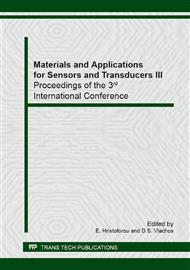p.202
p.207
p.211
p.215
p.219
p.223
p.227
p.231
p.235
Self-Texture Control of ZnO Films Prepared by Reactive RF Magnetron Sputtering
Abstract:
Zinc Oxide (ZnO) is a wide bandgap semiconductor material which can be successfully used for wide variety of potential applications such as biosensors or acoustic resonator devices. ZnO normally crystallizes in the wurtzite structure with c-axis (001) preferred orientation. However, for bio-sensing in liquids, it is necessary to generate a shear horizontal mode wave, where the wave displacement is within the plane of the crystal surface. For generation of such a shear horizontal wave, a-axis film textures such as the (110) or (100) is necessary. This work is focused on the preferred orientation control of ZnO film prepared by RF magnetron sputtering. It is found that preferred orientation can be controlled by substrate bias and substrate temperature during deposition without the use of expensive crystalline substrates. There are three areas of operating parameters when the structure of the ZnO films is dominated by different preferred orientation. Moreover, the film annealing was performed to enhance the film structure.
Info:
Periodical:
Pages:
219-222
Citation:
Online since:
April 2014
Authors:
Keywords:
Price:
Сopyright:
© 2014 Trans Tech Publications Ltd. All Rights Reserved
Share:
Citation:


